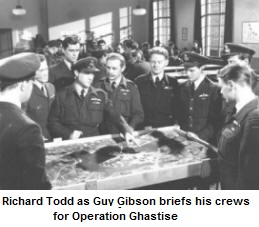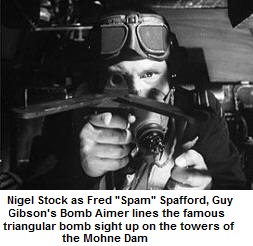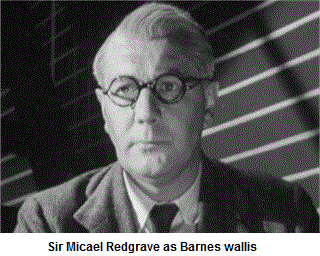|

In
the early 1950, Associated British Picture Corporation's (APBC) Director of
Production Purchased the film rights to Paul Brickhills book The Dam
Busters. He recruited
Michael Anderson to direct the film and
RC
Sherriff to write the screen play.
Richard Todd starred as Guy Gibson
and Sir Michael Redgrave as
Barnes Wallis. Though Sherriff hardly
mentioned the script in his autobiography it is widely regarded as one of
his best and on the film's release in September 1955 rapidly became the
highest grossing picture in Britain for that year.
ABPC allowed the budget for the film to go over the £150,000 limit they
normally set for a film, which meant they could use real Lancasters and RAF
aircrew from RAF Hemswell to fly them.
Many of the exteriors were filmed at Scampton, where 617 Squadron were
based at the time of the Dams Raid and at nearby Hemswell. The
interiors such as the briefing room at Scampton and the 5 Group operations room at
Grantham were faithfully reproduced on sound stages at ABPC's studios.
|
|

By
the mid-fifties Lancasters were becoming quite rare and the film company
were only able to use four, so they painted different serial numbers and
squadron codes on each side of those they had to make it appear as though
there were more aircraft than there were and used Lincolns, that from a
distance superficially resemble Lancasters as background dressing.
Lancaster buffs will know well enough that the aircraft used in the film
were Mark 7s by the guns in the rear turrets and the absence of flame
shrouds on the engine exhaust
Eric Coates is commonly credited with the writing the film music. In
reality he wrote only the famous
Dam Busters March. Leighton Lucas
wrote the actual film score
Dam Busters is a great film and I love it. However, the screenplay is
guilty of omission and of perpetrating a number of myths. Among that
Gibson's crew transferred with him to 617 Squadron from 106 Squadron. This is
not the case. Nor is it likely that Gibson had-picked all of his crews
though he may have asked for some of them by name, notably his Flight
Commanders
Squadron Leaders Melvyn Young and John Hopgood.
|
|

Everybody that has seen the film knows that Gibson got the idea of the
spotlights while visiting a show in London with his Bombing Leader
Bob Hay.
In fact the idea came from Benjamin Lockspieser, the civilian Director of Research at the Ministry of
Aircraft Production.
Not every bomb-aimer used the famous
triangular bomb sight developed by Wing Commander CL Dann. The sight
was effective but was far from perfect. Not every bomb-aimer had
sufficient accommodation in their eyesight to cope with the relative
distances between the peephole, the pegs and the towers on the dams.
Some bomb aimers drew chinagraph pencil lines on the bomb-aimers panel and
attached to screws on either side of the panel. A metal ring in the
centre of the string to replace the peephole on the Dann sight completed the
modification.
The bombs seen skipping across the water are not "Upkeep" weapons but a
development know as "Highball". Highball was a development of Upkeep
intended for use against ships. It was intended that should be used by
another top secret unit 618 Squadron. Highball was never used in
anger.
|
|
 The biggest omission for me is that the film concentrates only on the first
9 aircraft and crews that attacked the Mohne and Eder Dams and scarce
mention is made of the other waves. Two aircraft those of Joe McCarthy
and Ken Brown fought there way through to the Sorpe Dam and accurately
bombed it. Bill Townsend fought his way to the Eneppe Dam and bombed
that yet no credit is given in the film. In fact the only real mention
they get is a brief exchange between Cochrane AOC in C 5 Group and Harris
AOC in C Bomber Command in the Ops Room at Grantham. The biggest omission for me is that the film concentrates only on the first
9 aircraft and crews that attacked the Mohne and Eder Dams and scarce
mention is made of the other waves. Two aircraft those of Joe McCarthy
and Ken Brown fought there way through to the Sorpe Dam and accurately
bombed it. Bill Townsend fought his way to the Eneppe Dam and bombed
that yet no credit is given in the film. In fact the only real mention
they get is a brief exchange between Cochrane AOC in C 5 Group and Harris
AOC in C Bomber Command in the Ops Room at Grantham.
A New Zealand film company is re-making the Dam Busters in an attempt to
address some of these criticisms. Will it work? I'm not optimistic.
There are now only two airworthy Lancasters, both of which are priceless,
and neither of which the film company can use. One is owned by the
Royal Air
Force Battle of Britain Memorial Flight (BBMF) and the other is owned by
the
Canadian
Warplane Heritage Trust, which means the film company can only rely on
mock-ups, CGI and models. There is already controversy about whether
Gibson's dog, which in less PC times was named "Nigger" should be re-named.
What the PC brigade don't realise is that while it
is possible to edit a
film script, they cannot change history and it hardly makes sense to make
a film that supposedly corrects myths and errors if it starts by introducing
a myth of it own. Nigger was and forever will
be the name Gibson gave to his dog and a any true and accurate history will
always record that fact. The PC brigade need to
grasp the concept of historical context.
At the bottom of this page are three links to short excerpts to the film.
The first take off includes the moment when Richard Todd as Guy Gibson tells
the waiting crews that it is time to go. At this point Sherriff's
screen play, Anderson's direction and Lucas's score come together to make
one of the films most memorable moments as the crews are driven out to their
aircraft. The second and third are the attacks on the Mohne and Eder
dams. Notice the film of the bombs bouncing on the water and compare
them to the actual bombs taken at the
trials.
|
